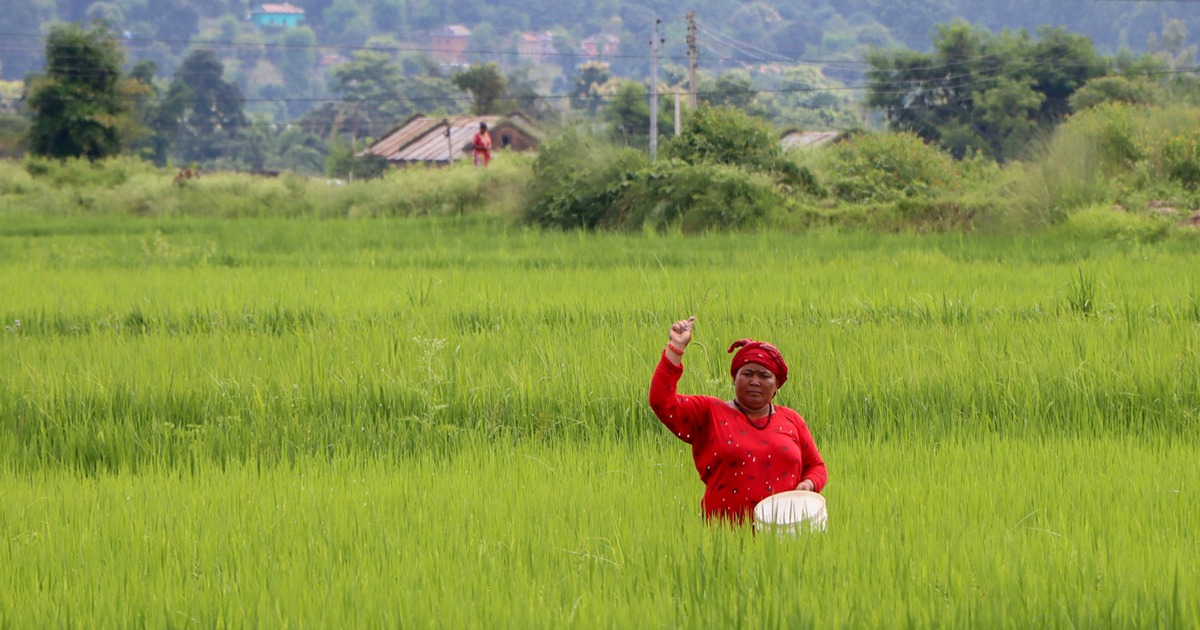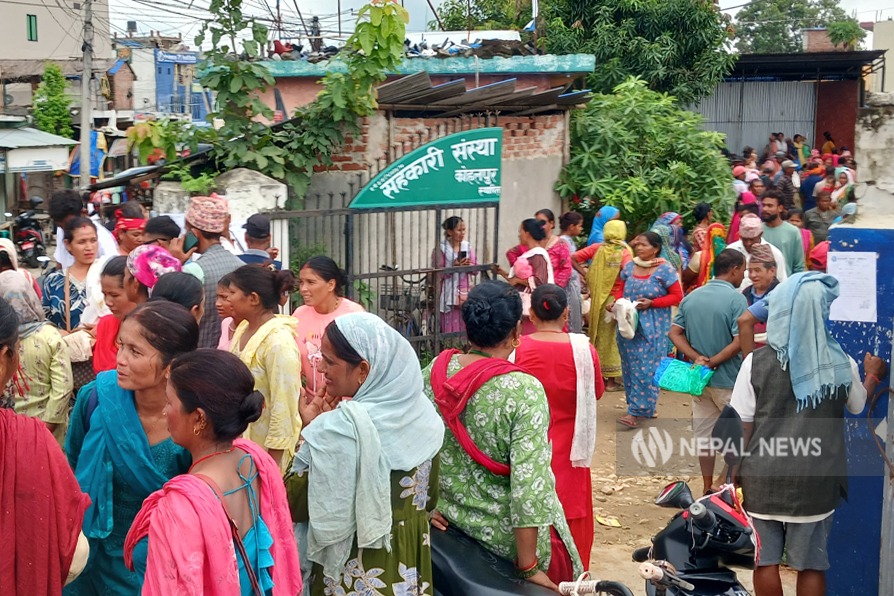

KATHMANDU: While Finance Minister Bishnu Prasad Paudel announced an allocation of nearly Rs 29 billion in the 2025/26 budget for the establishment of chemical fertilizer factories and fertilizer procurement, Krishna Bhusal from Gulariya, Bardiya, was still anxious about securing enough fertilizer for his paddy fields. “Hearing the budget speech makes one happy, but in the fields, there is always a shortage of fertilizer,” he says.
The issue of establishing a chemical fertilizer factory has been a recurring topic for Finance Minister Paudel, appearing in all three budgets he has presented. The first time was in the fiscal year 2016/17 budget, where he announced the establishment of chemical and organic fertilizer factories through a collaboration of government, private, and cooperative sectors. Five years later, in the fiscal year 2021/22 budget, he again had the opportunity to present the budget. This time, he set a three-year timeline for the factory, with initial work planned in the first year, but nothing materialized.
Most recently, in the budget speech for fiscal year 2025/26, Paudel again mentioned the fertilizer issue, stating, “Necessary preparations will be made to establish a chemical fertilizer factory through the Investment Board Nepal.”
Looking at Paudel’s budget speeches over a nine-year interval, instead of the fertilizer factory’s progress moving forward, it seems to have been repeatedly delayed. The first time, he announced the “establishment of the factory”; the second time, he said “initial work to start the factory will proceed”; the third time, the language shifted further to “necessary preparations will be made.” Reading these phrases in the budget and observing the progress makes it clear: Finance Minister Paudel has been raising farmers’ hopes with the promise of fertilizer factories while deceiving them.
It is not only Paudel; for nearly four decades, the fertilizer issue has been used by many finance ministers primarily as a means to placate farmers.
Fertilizer subsidies fall short, farmers still struggle
According to the Ministry of Agriculture and Livestock Development, Nepal imports chemical fertilizer worth approximately Rs 40 billion annually. The government provides subsidies on imported fertilizer. For this fiscal year, Rs 28.82 billion has been allocated for fertilizer subsidies. Out of the ministry’s total budget of Rs 57.48 billion for the current fiscal year, the subsidy allocation accounts for about half.
Similarly, in the previous fiscal year, out of a total budget of Rs 57.29 billion, about half—Rs 27.95 billion—was allocated for fertilizer subsidies. In FY 2023/24, out of a total budget of Rs 58.98 billion, nearly Rs 30 billion was earmarked for fertilizer subsidies.
Despite government assurances of factory establishment and budget allocations for subsidies, farmers continue to face constant fertilizer shortages, leaving them caught in a cruel irony.
Krishna Bhandari, a farmer from Barahakshetra, Sunsari, says the government is politicizing farmers’ suffering under the pretext of opening a fertilizer factory. “Once the factory is established, the commission stops, which is why policy-level corruption has persisted for years,” he alleges.

A woman spreading fertilizer in a paddy field on Wednesday in Bijauri, Tulsipur Sub-Metropolitan City-18, Dang. Photo: Deepak Bohara/RSS
Bhandari, who is also the accounting committee coordinator of Haridwar Agricultural Cooperative, deals in fertilizer in Barahakshetra. Even though the cooperative operates in wards 2 and 3, farmers from Ward 11, Prakashpur, also come looking for fertilizer, but he can supply only a quarter of the demand. Last year, he sold 64.5 metric tons of fertilizer.
Krishna Bhusal of Bardiya expresses even greater frustration. According to him, 56 sacks of fertilizer arrived at Gyanakunja Cooperative in Ward 1, Gulariya Municipality, which has 700 farmer members. Owning 3.5 bighas of land (one bigha equals 6,772.63 square meters), he waited in line for nearly four hours, only to be handed a single sack of fertilizer. Frustrated, he asked, “The government has fooled us in the name of fertilizer factories. How long will farmers have to endure this politics?”
Vidyananda Raya from Gaushala Municipality-12, Mahottari, who owns five bighas of land, says that even though there is a fertilizer dealer in Kantibazar, he never receives as much fertilizer as he requests. “We don’t even know where the government sends fertilizer or who receives it,” he says. As a result, he purchases fertilizer from Indian border markets illegally and applies it in his fields.
According to Januka Pandit, spokesperson for the Ministry of Agriculture and Livestock Development, Nepal needs 700,000 metric tons of fertilizer annually, while the government provides subsidies for 550,000 metric tons. “It is not possible to provide exact data on the shortfall,” she says.
In Nepal, the Krishi Samagri Company Limited and Salt Trading Corporation Limited have been handling the chemical fertilizer trade. The government provides subsidies for their purchases—70% of subsidized fertilizer is allocated to the and 30% to Salt Trading. These companies distribute the purchased fertilizer to farmers.
The fertilizer factory mirage
Examining the last 15 years of budget speeches reveals how the government has politicized the farmers’ needs.
Bharat Mohan Adhikari, regarded as the architect of “populist” budgets, announced in the FY 2011/12 budget that “to encourage the establishment of domestic fertilizer factories, a separate project to generate up to 100 MW of energy required will be initiated,” allocating Rs 3 billion for fertilizer subsidies that year.
Shankar Prasad Koirala, finance minister during Khilraj Regmi’s government, remained silent on fertilizer factories and subsidies in FY 2012/13, though in FY 2013/14, he announced a detailed feasibility study for establishing factories, allocating Rs 6.07 billion for subsidies.
Janardan Sharma, in the FY 2022/23 budget, proposed establishing a chemical fertilizer factory using green hydrogen and green ammonia technology through the Investment Board Nepal. Later, Nepali Congress Finance Minister Prakash Sharan Mahat proposed a different course, announcing that a detailed project report would be prepared and that the factory would be pursued through public–private partnerships under the Investment Board Nepal.” However, even prominent finance ministers such as Ram Sharan Mahat—who was named The Banker’s Global and Asia-Pacific Finance Minister of the Year in 2016—and Yuba Raj Khatiwada did not prioritize the establishment of a fertilizer factory.
During the last 15 years, Mahat presented the budget in FY 2014/15 and 2015/16, and Khatiwada from FY 2018/19 to 2019/20; neither mentioned the fertilizer factory. They only gradually increased subsidy allocations. Similarly, Maoist Centre finance ministers Krishna Bahadur Mahara and Barshaman Pun remained silent on fertilizer factories during their terms (Mahara: FY 2017/18; Pun: FY 2024/25).
Fertilizer factory feasible?
Former Finance Minister Khatiwada says it is not immediately feasible to establish a domestic fertilizer factory. Therefore, budget allocations are often made for popularity rather than practicality. While a domestic factory is necessary to meet demand, questions remain about technology reliability, production guarantees based on investment, and operational responsibility. “Talking about factory establishment as a political agenda in the budget alone is insufficient. Detailed preparations are needed,” he says.
Budget speeches serve as political and economic documents, guiding development and addressing the needs of all societal groups. After parliamentary approval, they acquire legal recognition. But governments have not been sensitive to critical issues affecting farmers. Former Agriculture Minister Ghanashyam Bhusal, in 2019, studied this in depth and concluded: “Instead of deceiving the world with promises of immediate fertilizer factories, a 10-year plan with detailed studies should precede actual factory establishment.”
At that time, urea cost Rs 43 per kg. A domestic factory would have produced it at Rs 55–57 per kg, making it unprofitable. Therefore, Bhusal prioritized government-to-government (G2G) agreements with India to purchase fertilizer. “Nepal should secure supply agreements with fertilizer-producing countries to resolve shortages,” he asserts.
42 years of studies, no factory
Attempts to establish chemical fertilizer factories in Nepal date back almost four decades, yet efforts remain limited to feasibility studies. The Japan International Cooperation Agency (JICA) conducted the first feasibility study around 1983, confirming that chemical fertilizer could be produced from air, water, and nitrogen, recommending electricity subsidies. Another study in 1995 concluded that electricity shortages made establishment unfeasible.
In 2020, the government formed a task force under then-Agriculture Secretary Rajendra Prasad Bhari to study past research and suggest practical solutions.
According to him, the Investment Board Nepal’s 2017 study was the most detailed, proposing a factory in Dhalkebar of Dhanusa district on 1,000 bighas with a 700,000 metric ton capacity, at an estimated cost of Rs 142 billion, requiring 115 MW of electricity.
“Based on past study reports, we provided recommendations on how to proceed to the implementation level,” he says. “We perceive the lack of strong political will and firm commitment, more than lack of resources, as the main obstacle.”
The government’s ‘National Fertilizer Policy, 2002’ encourages domestic chemical fertilizer production to reduce dependency on imports and promotes private and cooperative sector investment, including in neighboring countries’ factories.
Recently, on May 27, Prime Minister KP Sharma Oli chaired Investment Board Nepal meeting, reviewing the final detailed feasibility report from Germany’s DIAG Industries GmbH and deciding to form a task force to recommend suitable options.
Hari KC, joint secretary of the Ministry of Agriculture and Livestock Development, says that although the policy, program, and budget mention factory establishment, no concrete work has started. “We recognize the need for a domestic factory for smooth supply, but its establishment does not fall under the Agriculture Ministry,” he explains.
